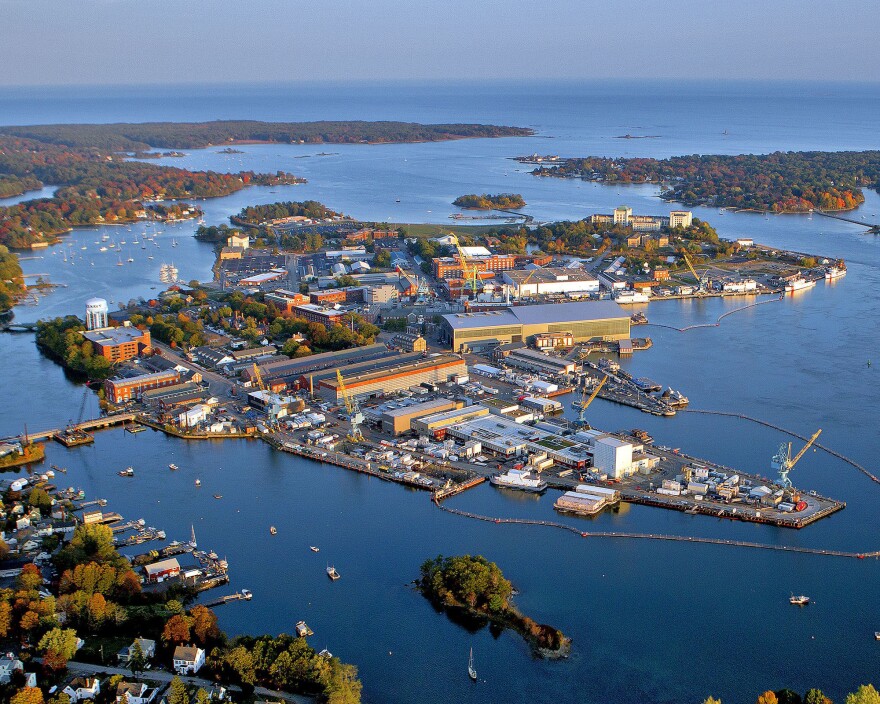“Climate resilience" has become a phrase that describes the efforts of scientists, conservationists and government officials to respond to sea-level rise, intense storms, and increasing temperatures.
The concept is getting the attention of military planners as well, and in Maine, the Portsmouth Naval Shipyard in Kittery is hardening its own historic facilities against higher tides, and adding flexibility to on-site energy systems.
This story is part of our series "Climate Driven: A deep dive into Maine's response, one county at a time."
For more than two centuries, the shipyard's been nestled on Seavey Island at the mouth of the Piscataqua River. With roughly 8,000 people there on any given day, it's a small town unto itself — an entire community focused on a singular goal — the upkeep of this nation's fleet of submarines.
You might think that high-tech submersibles would be uniquely suited to riding out the volatile effects of climate change. But, not when they're in drydock.
"When you have a submarine in overhaul in the dry dock, it's not water-tight any more. Right? We cut holes in the side of the submarine for access to get into different parts of the submarine so we can bring services in, so we can bring bigger equipment out," says Captain Dan Ettlich, the shipyard's commander.
He said, "You could imagine a worst-case event would be you get water coming over the drydock that's greater than the capacity of the dry dock pumps to keep up with, and now you start getting get a water-level event in that drydock and potentially hazarding the asset that we're working on."
The very expensive, potentially mission-critical assets that are today's modern subs. With sea levels predicted to rise between 3 and 6 feet here by the end of the century, their readiness could be at risk. And researchers say that as early as 2050, the shipyard is like to be subject to a lot more flooding.

"We found that with just the more conservative or intermediate conservative scenario, the shipyard will see about 80 flood events per year. So this is up from just about ten or so events per year today," says Shana Udvardy, a climate resilience analyst at the Union of Concerned Scientists.
In 2016, that group issued a report on the military's readiness for rising seas. She says since then, scenarios pointing to greater flood risks are proving to be more likely.
"With the highest scenario which is unfortunately the track that we are on, the shipyard would see over about 190 tidal flood events by mid-century, and that's over a half the year, so that really is quite concerning," Udvardy says.
Udvardy and other scientist activists say the military needs to do more to prepare — and that the U.S. government must do more to reduce climate-changing pollution.
Shipyard executives say about five years ago they did start to think more carefully about bringing climate predictions into infrastructure scoping and design — and that's now showing up in construction projects on site .
"That really has been kind of an evolution over the past couple of years," says Deputy Public Works Officer Russell Gagner.
He says the investments to harden facilities against sea-level rise and more damaging weather events are now considered essential for military readiness.

"The Secretary of Defense has acknowledged that climate change is real, and all the installations need to be resilient. Obviously, Navy bases are on the waterfront typically, and obviously they have a vested interest in climate change and sea-level rise, so there's recognition that we need to be investing in the resiliency of these installations to match climate change," he says.
An upcoming $2 billion general overhaul of yard facilities includes integrated measures to protect against higher tides, storm surges, and potentially catastrophic combinations of the two.
Commander Ettlich says that they will cost less than 10% of the construction budget, but are being deployed everywhere possible. In essence they are adding two-to-three feet to the height of any given seawall, drydock, pier or berth, to electricity plant barriers, even street curbs.
"So really, by the time we're done with these projects, at least 80% of the critical areas around the waterfront will have some form of new protection," he says.
And the shipyard's resilience planning goes beyond just construction add-ons: The facility now includes a new high-efficiency gas-powered combined steam and power turbine, a grid-scale Tesla battery system and an island-scale microgrid to control it all.
Those efforts are improving the yard's energy efficiency. But they also aim to protect the continuity of energy supply against outages, whether caused by local disruptions, or by storm events that are becoming increasingly frequent — and intense.



